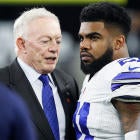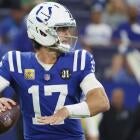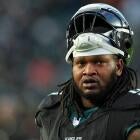
How historic Ezekiel Elliott contract impacts Cowboys cap space, and why they can still afford everyone
You've heard the lie about the Cowboys salary cap, only you thought it was the truth, until now
You've been lied to, but it's time to set the record straight when it comes to the Dallas Cowboys salary cap. Yes, the brass in North Texas can afford to pay all of their stars and still have plenty of change left for other sugary treats.
What you need to understand is how.
This is a salary cap truth that stands even after a recent slate of contract extensions headlined by the record-setting deal awarded to running back Ezekiel Elliott, with his six-year, $90 million extension carrying a $50 million guaranteed figure -- bringing his total contract to eight years at roughly $103 million. It's the most ever paid to a running back in the history of the NFL, and ends a 40-day long holdout by Elliott in the process. With the two-time NFL rushing champ now officially signed and back at practice in time to prep for the team's Week 1 battle with the New York Giants, it's time to dissect both the structure of his deal and the impact of it on the Cowboys overall salary cap figure for 2019 and beyond.
Our very own Joel Corry of CBS Sports presents an eloquent dissection of Elliott's deal as a standalone item along with an assessment of which side came out with the longer end of the stick, and I'll tie it all together here; as it relates to the macro.
First, a look at the annual numerical framework of Elliott's new contract.
| Year | Base Salary | Prorated Bonus $$ | Total Cap Hit | Dead Money (Pre-June 1 release) | Cap Savings (Pre-June 1) | Annual Cash Flow |
|---|---|---|---|---|---|---|
2019 | $752,137* | $1,500,000 | $6,339,653** | $32,139,653 | -$25,800,000 | $8,252,137 |
2020 | $6,800,000* | $4,100,000 | $10,900,000 | $25,800,000 | -$14,900,000 | $19,800,000*** |
2021 | $9,600,000 | $4,100,000 | $13,700,000 | $14,900,000 | -$1,200,000 | $9,600,000 |
2022 | $12,400,000 | $4,100,000 | $16,500,000 | $10,800,000 | $5,700,000 | $12,400,000 |
| 4-year g'td sum: | $50,052,137 | |||||
2023 | $10,900,000 | $4,100,000 | $15,000,000 | $6,700,000 | $8,300,000 | $10,900,000 |
2024 | $10,000,000 | $2,600,000 | $12,600,000 | $2,600,000 | $10,000,000 | $10,000,000 |
2025 | $15,400,000 | $0 | $15,400,000 | $0 | $15,400,000 | $15,400,000 |
2026 | $16,600,000 | $0 | $16,600,000 | $0 | $16,600,000 | $16,600,000 |
| Sum | $82,452,137 | $107,039,653 | $102,952,137 |
Key contract notes:
*base salary is fully guaranteed
**contains rollover cap hit of $4,087,518 (final portion of signing bonus from initial rookie deal; is not additional cash flow)
***includes $13 million option bonus that will activate in March 2020
__
The fire escape for the Cowboys will be in 2023, when Elliott's dead money is surpassed by cap savings if he's cut, although he will have gained his fully guaranteed sum by that point anyway.
From a team aspect, Elliott's contract will reward the Cowboys with $1.6 million in additional 2019 cap space due to a first-year reworking of the deal, and they'll add that to the $5.7 million gained by extending right tackle La'El Collins only one day prior. As they ramp up their pursuit of an extension on both quarterback Dak Prescott and wide receiver Amari Cooper -- more so the former, for now -- they'll do so with plenty of cash on hand to accomplish both missions, should either or both opt to sign.
For the first time in quite a while, the Cowboys will have a sizable financial cushion to work with going into the offseason as well, with the league having already set a new bar for 2019. For those who actually understand how this all financial rigmarole works, you already know there is no such thing as the mythical "salary cap hell", so to speak. Wise teams always find a way to make the cap work for them, be it with pay cuts, restructures, releases or the like. Building successfully through the NFL Draft also helps in a major way, with the goal being to land exceptional talent for pennies on the dollar — something the Cowboys have now become arguably the best in the league at doing.
That said, when it comes to salary cap space, it will always be "the more, the merrier". This past spring, the NFL announced the new cap number will be $188.2 million. For those who believe the cap is static, that's a 41.5% increase over the 2014 season — in a span that's seen the figures raise by more than a literal $10 million per team, per year.
What does this mean for the Cowboys, specifically?
Well, considering they also rolled over approximately $11.7 million in savings from 2018, it means they're available cap in 2019 had a floor of around $50 million. That rollover was the highest of any NFC East team and the second-most in the conference, behind only the San Francisco 49ers, who enjoyed $35 million gained from the previous year. Though dwarfed by the Niners, that's a lot of scratch for a Cowboys' team that usually carries a much smaller cushion, and it all comes not a moment too soon. The 2019 space also included the expiration of nearly $17 million in dead money, stemming from the releases of Tony Romo and Dez Bryant, helping to free up dollars for needed contract extensions and free agency signings -- the latter now being much less of a need for 2019.
Currently sitting at nearly $19.5 million in space ahead of 2019 training camp, any unused amount will attach itself to what is already a projected $75 million in cap space for 2020, pushing the number that much higher. That leads to a massive number barreling down the pike, and yet it's before factoring in contracts that will expire and not be renewed, general roster cuts, any retirements, possible restructuring of existing deals and potential pay cuts, and it includes the elimination of $4.27 million in expiring dead money from the contracts on Terrance Williams, Charles Tapper, and Orlando Scandrick.
Mathematically speaking, the Cowboys can wave their collective hand and very easily enter the 2020 league year with over $100 million in cap space. As it stands, they're projected to have around $87 million to start, and roster churn plus rollover will push the figure closer to the triple-digit marker as a baseline.
For contrast, here's how much cap space the Cowboys had going into each season since the turn of the decade:
| Year | Cap Space |
|---|---|
2011 | $30 million |
2012* | -$9 million (over) |
2013 | $3 million |
2014 | $4 million |
2015 | $10 million |
2016 | $6 million |
2017 | $9 million |
2018 | $11 million |
*docked $10M as an NFL penalty for front-loading contracts during uncapped 2010 season
That, ladies and gentlemen, is what "cap hell" looks like.
Even then, the Cowboys found ways to finagle things, but it ultimately came back to bite them time and again when you consider that restructuring a contract simply pushes back payment and doesn't actually delete it. They were constantly patching leaks in the dam, but it's not until 2019 that construction on the new dam was completed, and the water it will allow them to hold for the next half-decade or more is like something they've never seen before. Any attempts to undermine this reality with casual, sweeping and wholly incorrect takes that simply breeze past the numbers for the sake of pushing a narrative is more akin to some type of "salary cap PTSD" than it is actual analysis.
But wait, there's more for you to chew on, assuming your jaw is strong enough.
Much like with the DeMarcus Lawrence contract, the star defensive end who signed a five-year, $105 million extension in April, the Cowboys can actually gain cap space by extending wide receiver Amari Cooper this year. Approximately $10 million in 2019 was gained by moving on Lawrence, and a new deal for Cooper could and likely will be worked in a way that cuts a chunk out of his current $13.9 million cap hit for this year -- as was the case on both Collins and Elliott. Mathematically speaking, the only extension that's actually created a decrease in the team's 2019 cap is that of linebacker Jaylon Smith, but even that was merely a rub of $500,000. In reality, the Cowboys have been doing two things this offseason: Extending top talent, and simultaneously creating more cap space in the process -- not less.
Impressive.
So who gets left out of all of this? The beauty of it for the Cowboys is, no one has to. If someone walks, it'll be because the team opted to not match their asking price, but certainly not because they can't or because they'll pay for it all later. The thing about later is simple, because there's a new Collective Bargaining Agreement currently being negotiated -- which will likely have a massive impact on what the salary cap looks like in 2021 and beyond -- and, at minimum, the league increases the cap each year anyway thanks to windfall revenues.
Now as far as star players go, admittedly, they're not all created equally. There are Tier-A talents like those mentioned above, and there are Tier-B guys who are still malleable in a financial capacity. One such person is cornerback Byron Jones, who doesn't carry a ton of leverage thanks to the Cowboys nearly flexing him into oblivion over the course of his first three NFL seasons. It wasn't until passing game coordinator and Legion of Boom engineer Kris Richard landed in North Texas that Jones was moved to corner full-time, and he became one of the best in the league en route to landing his first-ever Pro Bowl and All-Pro nods.
That's enough to warrant an extension, yes, but nothing that will cause him to reset the market [right now].
If the Cowboys can get Jones an extension before 2020, he'll likely be a $10 million per year player. Team-friendly deals obviously exist, as noted with Smith and Collins, and Jones could very well fall into the category of a player willing to accept a bit less to remain in a city he loves and with a coordinator he adores. There's no way to guarantee any player opts to take less money, though, and this is more of a reminder that should the Cowboys want to retain him -- the money is there.
And then there's defensive lineman Maliek Collins, who is also entering a contract year. The reality on Collins is even if he breaks out, the Cowboys still have leverage by virtue of his injury history -- although he's avoided missing much time in the autumn -- along with their current depth across the defensive front.
They'll want to keep Collins if they can -- but at the right price. It's more likely if it comes down to Jones or Collins, it's the stud cornerback who'll get the nod, but be not mistaken when I say both can be extended without the team batting an eye. Of course, you've been told differently by many who don't understand how the cap truly works and, subsequently often find themselves trying to figure out how teams like the Los Angeles Rams and Philadelphia Eagles continue to manipulate the cap.
There's the first real hint that something's missing in those analysts' views. What missing is, again, understanding.
For perspective, lets now add the current cap space figure for the Cowboys -- along with the 2020 projection -- to the table above from earlier, for a clearer visual impact:
| Year | Cap Space |
|---|---|
2011 | $30 million |
2012* | -$9 million (over) |
2013 | $3 million |
2014 | $4 million |
2015 | $10 million |
2016 | $6 million |
2017 | $9 million |
2018 | $11 million |
| 2019 (Current) | $22.8 million* |
| 2020 (Projected) | $87.294 million* - $100 million (+) |
*via Spotrac
Granted, new (re-)signings will impact how close or far to the 2020 savings ceiling the Cowboys will truly get, but even if they have "only" $40 million in space left after securing Lawrence, Smith, Collins, Elliott, Prescott, Cooper, and Jones -- as a rough example, and assuming the argument the latter three opt to sign no later than 2020 -- the Cowboys would still have $10 million more than the most they've had since 2010. That's more than enough to pay satellite talent, and to acquire free agents they deem worthy of paying.
When considering this is also a club that very rarely overextends themselves by waging war in the first wave of NFL free agency in any given year, we're talking about value deals landed in the second and third wave that are very cost-effective and allow for easy exits.
They accomplished such this very offseason with defensive end Robert Quinn and wide receiver Randall Cobb.
There's also irony in the fact that the extensions self-proclaimed cap specialists are arguing over, will be bargains just two years after they're signed, if not sooner. In dissecting the current and future cap numbers, the roster and subsequent attrition +/- additions, willing team-friendly deals from veterans (ex: Jason Witten, Sean Lee, etc.), how the Cowboys conduct spring business and market values on respective players, and the reality that the front office in North Texas is setting the gold standard for how to draft talent -- it's as laughable as it is odd to still hear the PTSD-style narrative of cap hell as it relates to Dallas.
They'll continue to sell how fast the pie is supposedly dwindling, and you'll probably buy it, as you have all offseason. What they aren't revealing to you, however, is what I've just explained in great detail. There's a warehouse full of pies in back, and they're homemade apple pies. Who will land the next slice? Will it be Prescott, Cooper, Jones or someone unforeseen?
The short answer is, whoever's hungry.


















